Popular games published by company Commodore Business Machines, Inc.
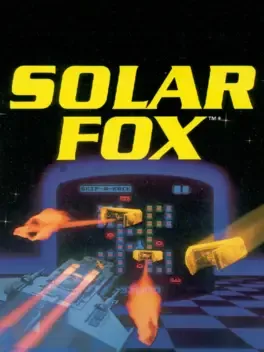
Run over or shoot "Fuzors" while ships on each of the four sides of the screen travel back and forth or up and down trying to shoot you.

Wizard of Wor is an action-oriented game for one or two players. The game takes the form of several maze-like dungeons infested with monsters. The players' characters, called Worriors, have to kill all the monsters. Player one has yellow Worriors, on the right, and player two has blue Worriors, on the left. In a two-player game, the players are also able to shoot each other's Worriors, earning bonus points and causing the other player to lose a life. Team-oriented players can successfully advance through the game by standing back-to-back (such as in a corner) and firing at anything that comes at them.

Set in the year 2003, the game involves using a spaceship to destroy enemy droid ships. The player's ship is controlled with a spinner to rotate the ship, a button for thrusting, and a button for firing lasers. The enemies that the player must destroy or avoid are drone ships, commander ships, two types of space mines, and shooting star ships. The ship bounces off an invisible barrier on the edges of the screen that briefly appears when hit. By default, Extra ships are awarded at 40,000 and 100,000 points, but this can be changed by the machine's owner.
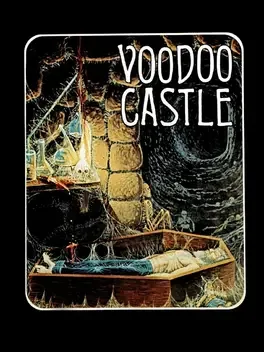
You are Count Cristo and a curse has been put on you. Your have to lift the curse in this text adventure using two word commands.
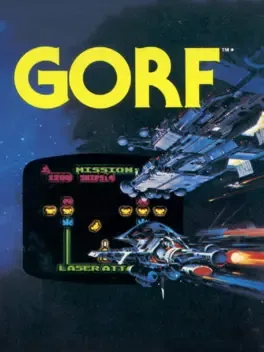
Gorf actually consists in the Arcade version of five different types of space shooters. The first one ist basically is a Space Invaders clone. In the second one a formation of space ships is hovering at the top of the screen while single space ships will disengage from the formation and dive down at you. The third variant is a Glaxian clone and only available in the Arcade version. In the fourth mini-game the enemy will come out of a circular hyperspace field and attack you. After having destroyed four of your attackers the game proceeds to the fifth game stage. Here a huge mothership is dropping bombs at you from the top of the screen. You defeat the mothership with a well placed projectile hitting it between its two major sections. After that the game starts from the gebinning on a higher difficulty level.
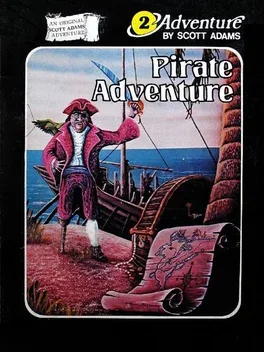
Your goal in this text adventure is to find a pirate treasure using two word commands.
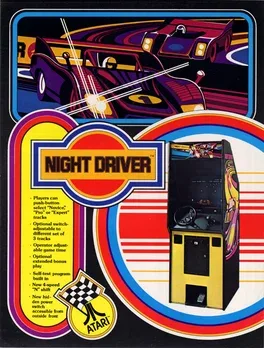
The player controls a car which must be driven along a road at nighttime without crashing into the sides of the road as indicated by road side reflectors. The game is controlled with a single pedal for gas, a wheel for steering and a four-selection lever for gear shifting. The coin operated game had a choice of three difficulties, novice, pro, and expert, from which the player could choose at game start. The turns were sharper and more frequent on the more difficult tracks. As play progresses, the road gets narrower and more winding.
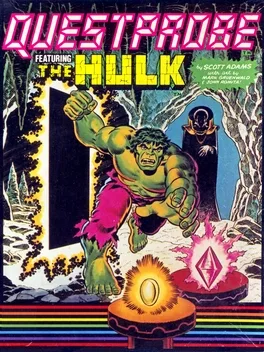
Questprobe featuring The Hulk is a graphic adventure video game. It is the first entry in Questprobe, an intended series of graphic adventure games that only released three instalments before the developer's bankruptcy. The game's narrative follows the Marvel superhero Hulk and his human alter-ego Bruce Banner (in their first video game appearance), who must explore the mysterious lair of the Chief Examiner.
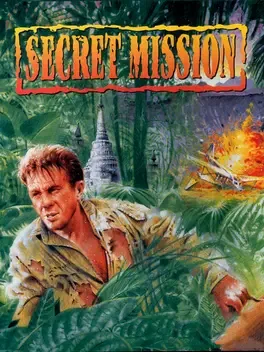
This adventure takes place in a nuclear power plant and using two word commands you must prevent a reactor meltdown.
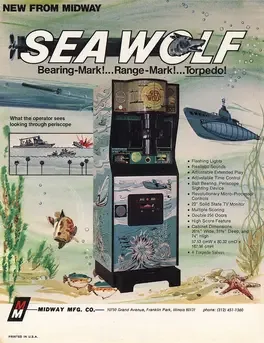
Sea Wolf is an arcade game by Midway, originally released in 1976. The player looks through a large periscope to aim at ships moving across the virtual sea line at the top of the screen, using a thumb button on the right handle of the scope to fire torpedoes. The periscope swivels to the right and left, providing horizontal motion of a targeting cross-hair. The cabinet features a mixture of video game and older electro-mechanical technology for player feedback. Using back-lit transparencies reflected inside the scope, the number of torpedoes remaining are displayed, as well as a red "RELOAD" light which lights up momentarily when the player has launched five torpedoes. Additionally, when ships are hit on the screen, an explosion "light" is reflected inside the scope. A blue overlay is affixed to the screen to provide a "water color" to the sea. Sounds include a sonar ping and the sound of the PT Boat racing across the screen. Sea Wolf is time-limited, with the player having an opportunity to win bonus time by reaching an operator-set score. The player's score is shown on the bottom half of the screen as well as the high score, one of the first known instances of a high score in a video game. Targets include destroyers, a fast moving PT Boat, and mines floating across the screen can that serve as obstructions.

Satan's Hollow is a shoot 'em up arcade game released by Bally Midway in 1982, subsequently converted to the Atari 8-bit family, and in 1984 to Commodore 64.
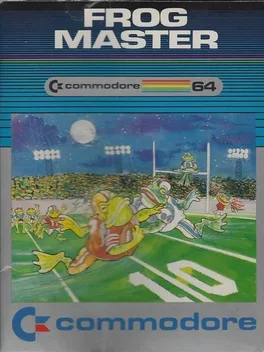
Frogmaster is a soccer game for one to four players. The players control tadpoles on the pitch, which react to joystick input which act as rewards. The player must train the tadpoles to score goals by reaching the other side of the pitch. Added challenge is generated by walls on the pitch and evolving tadpoles into frogs which can lay eggs and eat other tadpoles. In the original Mainframe version there were only frogs.
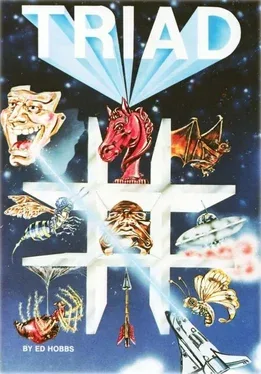
A Tic-Tac-Toe variant with shoot 'em up elements written by Ed Hobbs and published by Adventure International.
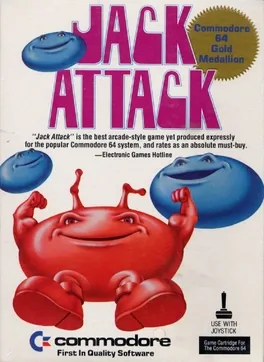
Jack Attack is a puzzle game released on the Commodore 64 and 16.
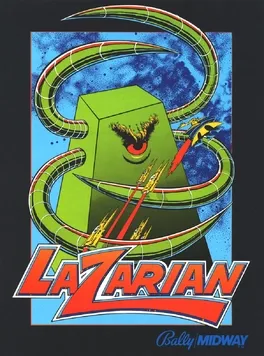
This Bally Midway fixed screen space shooter was ported to the Commodore 64.

You have to find and fight a dragon on the backside of your flying horse.
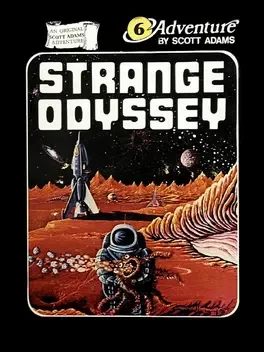
While orbiting an asteroid your space ship malfunctions. In this text adventure you have to find five alien artefacts - and a way home.
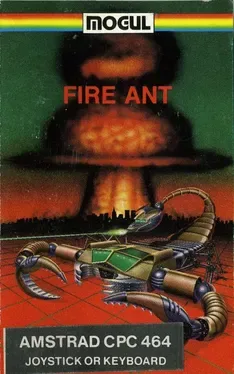
The player controls an ant which has to save the ant queen.
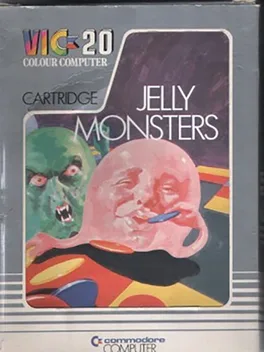
Jelly Monsters was originally developed as a port of Pac-Man by HAL Laboratory for Commodore Japan, who held the home computer rights for Pac-Man in Japan at the time. When Commodore released it internationally the title was changed to Jelly Monsters, since Atari held the home computer rights for North America. Commodore’s Jelly Monsters was released in 1981, a year before Atari would release Pac-Man for the 2600. Atari quickly sued Commodore to have the title removed from shelves and won.
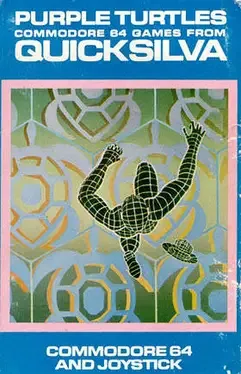
Purple Turtles is a Commodore 64 game where players cross a lake on the backs of purple-shelled turtles.

Origin The original SARGON was written by Dan and Kathleen 'Kathe' Spracklen in a Z80-based computer called Wavemate Jupiter III[1] using assembly language through TDL Macro Assembler. The name was originally written entirely in capitals because early computer operating systems such as CP/M did not support lower-case file names. Introduction SARGON was introduced at the 1978 West Coast Computer Faire where it won the first computer chess tournament held strictly for microcomputers, with a score of 5-0.[2][3] This success encouraged the authors to seek financial income by selling the program directly to customers. Since magnetic media were not widely available at the time, the authors placed an advert in Byte Magazine and mailed $15 photocopied listings that would work in any Z80-based microcomputer.[1] Availability of the source code allowed porting to other machines. For example, the March–April 1979 issue of Recreational Computing describes a project that converted Sargon to an 8080 program by using macros. Later the Spracklens were contacted by Hayden Books and a book was published.[4] Commercialization through electronic media When magnetic media publishing became widely available, a Navy Petty Officer, Paul Lohnes, ported Sargon to the TRS-80, altering both graphics, input, and housekeeping routines leaving the Spracklen's chess-playing algorithm intact. Paul consulted with the Spracklens, both living in San Diego at the time, to make the TRS-80 version an instant success with the help of Hayden Book's newly established software division: Hayden Software. Paul was not involved in further refinements to the TRS-80 version due to his reassignment to sea duty shortly after signing the deal with Hayden Software. In the early 1980s SARGON CHESS was ported to several earlier microcomputers, i.e. NASCOM (by Bits & PCs, 1981), Exidy Sorcerer, Sharp MZ 80K,[5] and many others. A complete rewrite was necessary later for the Apple II port, made by Kathleen's brother Gary Shannon. Both were published by Hayden Software. Sequels The Spracklens made significant improvements on the original program[1] and released Sargon II. In 1978 it tied for third at the ninth North American Computer Chess Championship despite being seeded ninth of 12 entries. Sargon finished only behind Belle and Chess 4.7, and defeated AWIT—running on a $5 million Amdahl mainframe—amazing the audience.[6][3][1] That year they published a series of articles in BYTE on computer chess programming,[2][7] stating "we think it would be nice if not everyone had to reinvent the wheel".[6] Sargon II was ported to a variety of personal computers popular in the early 1980s.[8] The game engine featured multiple levels of lookahead to make it more accessible to beginning chess players. BYTE in 1980 estimated that Sargon II had a 1500 rating at the highest tournament-time difficulty level, and speculated that it was the best chess program on sale, including dedicated devices.[9] Sargon 2.5, sold as a ROM module for the Chafitz Modular Game System, was identical to Sargon II but incorporated pondering.[10] It received a 1641 rating at the Paul Masson tournament in June–July 1979, and 1736 at the San Jose City College Open in January 1980.[3] Sargon 3.0 finished in seventh place at the October 1979 North American Computer Chess Championship. The competition had improved, but 3.0 drew against Cray Blitz and easily defeated Mychess, its main microcomputer rival. In December 3.0 easily won the second microcomputer championship in London.[3] In 1980, the Spracklens' Reversi game finished in first place at a computer tournament at Northwestern University, and in 1981 it finished in third place at the Santa Cruz Open Othello Tournament.[11] Sargon III was a complete rewrite from scratch. Instead of an exchange evaluator, this version used a capture search algorithm. Also included was a chess opening repertoire. This third version was written originally for the 6502 assembler and was commercially published by Hayden Software in 1983. Apple contacted the Spracklens and, after a port for 68000 assembly, Sargon III was the first third-party executable software for the Macintosh.[1] After the demise of Hayden Software, later chess programs were also released under the name Sargon, including Sargon IV (Spinnaker Software), Sargon V (Activision) and a CD-i title simply named Sargon Chess. The Spracklens concurrently wrote the engines for the dedicated chess computers produced by Fidelity Electronics, which won the first four World Microcomputer Chess Championships.

Cosmic Cruncher is a maze game for the Commodore Vic 20.
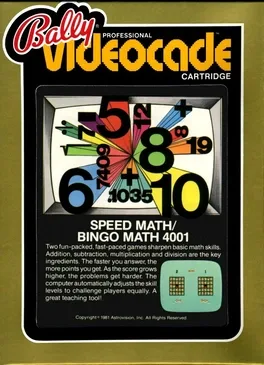
Elementary math / Bingo Math is a collection of two educational math games. The game helps improve skills in addition, subtraction, multiplication and division. Points are awarded based on speed and math problems get harder the higher the current score. Difficulty adjusts automatically to player skill.
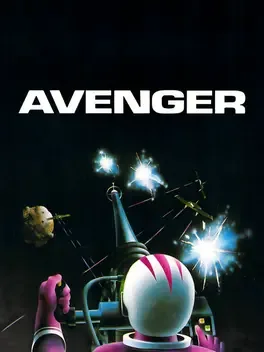
Avenger is a Space Invaders variant. The player has to defend Earth from endless rows of attacking aliens. Flying saucers can be shot for extra points.